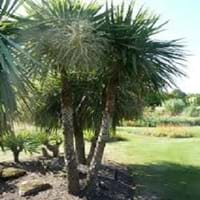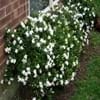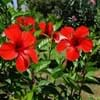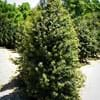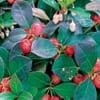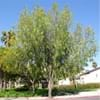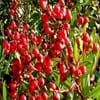What is
Life Span
Perennial
Perennial
Type
Broadleaf Evergreen
Broadleaf Evergreen
Origin
Eastern Asia
New Zealand
Types
G. 'Radicans', G. 'Aimee',G. 'Golden Magic'
Not Available
Habitat
Subtropical climates, Temperate Regions
Coastal Regions
USDA Hardiness Zone
7-10
8-11
AHS Heat Zone
Not Available
Not Available
Sunset Zone
21,22
21,22
Habit
Oval/Rounded
Upright/Erect
Information
Plant Size
Minimum Height
105.00 cm
99+
610.00 cm
99+
Minimum Width
135.00 cm
99+
240.00 cm
99+
Plant Color
Flower Color
White, Ivory
White
Flower Color Modifier
Bicolor
Bicolor
Fruit Color
Orange Red, Brown
White, Blue
Leaf Color in Spring
Dark Green
Burgundy, Dark Red, Copper
Leaf Color in Summer
Dark Green
Burgundy, Dark Red, Copper
Leaf Color in Fall
Dark Green
Burgundy, Dark Red, Copper
Leaf Color in Winter
Dark Green
Burgundy, Dark Red, Copper
Shape
Leaf Shape
Lance shaped
Long Narrow
Thorns
No
No
Season
Plant Season
Spring, Summer, Fall, Winter
Spring, Summer, Fall, Winter
Growing Conditions
Sunlight
Full Sun, Partial Sun
Full Sun, Partial Sun, Partial shade
Growth Rate
Medium
Fast
Type of Soil
Loam, Sand
Loam, Sand
The pH of Soil
Acidic, Neutral
Neutral, Alkaline
Soil Drainage
Well drained
Well drained
Bloom Time
Late Spring, Early Summer, Summer, Late Summer
Late Spring, Early Summer, Summer
Repeat Bloomer
No
No
Tolerances
Not Available
Drought, Salt
Care
Where to Plant?
Container, Ground, Pot
Ground
How to Plant?
Cuttings, Tip cutting
Stem Planting, Transplanting
Plant Maintenance
Medium
Medium
Watering Plants
Watering Requirements
Keep the Soil well drained, Needs less watering, Requires consistently moist soil, Use Mulches to help prevent water loss during hot and windy weather
Average Water Needs
In Summer
Average Water
Lots of watering
In Spring
Moderate
Moderate
In Winter
Average Water
Average Water
Soil
Soil pH
Acidic, Neutral
Neutral, Alkaline
Soil Type
Loam, Sand
Loam, Sand
Soil Drainage Capacity
Well drained
Well drained
Sun Exposure
Full Sun, Partial Sun
Full Sun, Partial Sun, Partial shade
Pruning
Remove damaged leaves, Remove dead branches, Remove dead leaves
Prune if you want to improve plant shape, Remove damaged leaves, Remove dead leaves
Fertilizers
All-Purpose Liquid Fertilizer
All-Purpose Liquid Fertilizer
Pests and Diseases
Aphids, Mealy bugs, Spider mites, Whiteflies
Red blotch
Plant Tolerance
Not Available
Drought
Facts
Flowers
Showy
Insignificant
Flower Petal Number
Double
Single
Fruits
Showy Fruit
No
Yes
Edible Fruit
No
Yes
Fragrance
Fragrant Flower
Yes
Yes
Fragrant Fruit
No
No
Fragrant Leaf
No
No
Fragrant Bark/Stem
No
No
Showy Foliage
Yes
Yes
Showy Bark
No
No
Foliage Texture
Medium
Coarse
Foliage Sheen
Glossy
Not Available
Evergreen
Yes
No
Invasive
No
No
Self-Sowing
No
No
Attracts
Birds, Butterflies
Caterpillar, Moths
Allergy
Hay fever, Mild Allergen
Asthma
Benefits
Uses
Aesthetic Uses
Beautification, Bouquets, Informal Hedge, Showy Purposes
Beautification, Landscape Designing, Showy Purposes
Beauty Benefits
Not Available
Not Available
Edible Uses
Yes
Yes
Environmental Uses
Air purification
Air purification
Plant Benefits
Medicinal Uses
chest congestion, cholesterol-lowering, Detoxification
Diabetes, Dysentry, Stomach pain
Part of Plant Used
Flowers, Fruits
Leaves, Root, Stem
Other Uses
Cake, Can be boiled and seasoned, pickled, Jam, Used as preservative
Decoration Purposes, Employed in herbal medicine, Showy Purposes, Used As Food, Used as Ornamental plant
Used As Indoor Plant
Yes
No
Used As Outdoor Plant
Yes
Yes
Garden Design
Container, Cutflower, Feature Plant, Foundation, Houseplant, Mixed Border, Topiary, Bonsai, Espalier
Container, Feature Plant, Foundation, Houseplant, Screening, Wind Break, Tropical
Scientific Name
Botanical Name
GARDENIA jasminoides 'Frostproof'
CORDYLINE australis 'Red Star'
Common Name
Cape Jasmine, Frostproof Gardenia, Gardenia
Cabbage Palm
In Hindi
Gardenia jasminoides
गोभी पेड़
In German
Gardenie
Cabbage tree
In French
Cape Jasmine
arbre de chou
In Spanish
Gardenia jasminoides
árbol de la col
In Greek
Cape Jasmine
λάχανο δέντρο
In Portuguese
Gardenia jasminoides
repolho árvore
In Polish
Gardenia jaśminowata
kapusta drzewo
In Latin
Gardenia mucronata
brassica ligno
Classification
Kingdom
Plantae
Plantae
Phylum
Tracheophyta
Magnoliophyta
Class
Magnoliopsida
Liliopsida
Order
Gentianales
Asparagales
Family
Rubiaceae
Asparagaceae
Genus
Gardenia
Acidosasa
Clade
Angiosperms, Asterids, Eudicots
Angiosperms, Monocots
Tribe
Not Available
Not Available
Subfamily
Not Available
Lomandroideae
Number of Species
Not Available
4
99+
|
||
|
||
|

